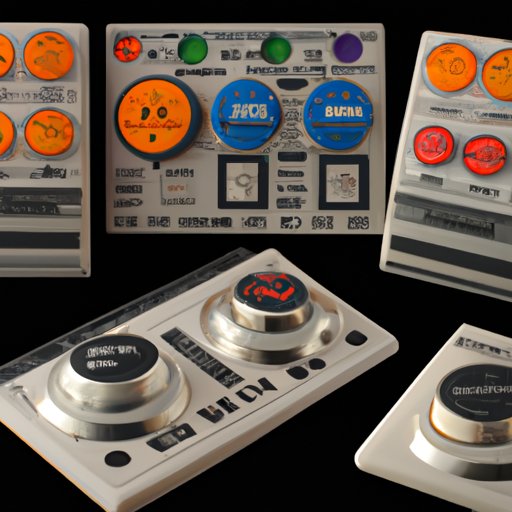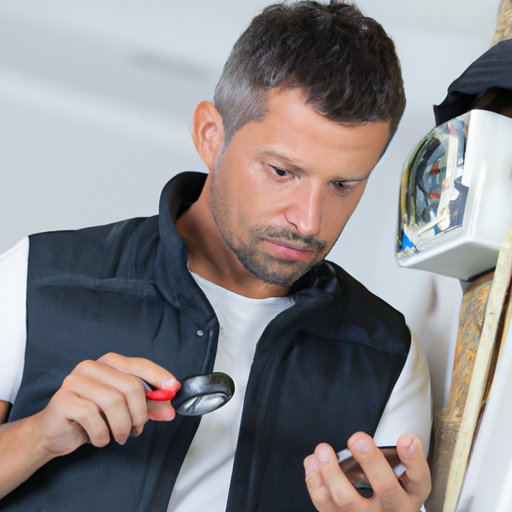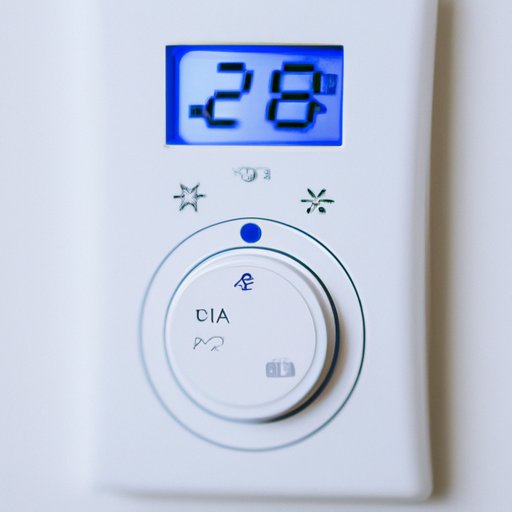Introduction
A thermostat is an essential part of any home or commercial building’s heating and cooling system. It is responsible for controlling the temperature by sensing changes in the air and then adjusting the heating or cooling accordingly. But how does a thermostat work? This article will explore the science behind thermostats, as well as the different types and their benefits.
A Step-by-Step Guide to How a Thermostat Works
At its most basic level, a thermostat is a temperature-sensing device that controls a heating or cooling system. It does this by measuring the air temperature and then turning the system on or off as needed to maintain the desired temperature. Here is a step-by-step guide to how a thermostat works:
Describing the Components
A thermostat consists of several components, including a thermistor, a bimetal strip, and a switch. The thermistor is a temperature-sensitive resistor that measures the ambient air temperature. The bimetal strip is a strip of two metals with different thermal expansion coefficients which bend when heated or cooled. This bending is used to actuate the switch, which turns the heating or cooling system on or off.
Explaining the Operation
When the air temperature rises or falls, the thermistor detects the change and sends a signal to the bimetal strip. The bimetal strip then bends, activating the switch and either turning the heating or cooling system on or off. When the desired temperature is reached, the bimetal strip relaxes and deactivates the switch.

Explaining the Science Behind Thermostats
Thermostats rely on two scientific principles: thermodynamics and mechanical and electrical components. Thermodynamics is the study of heat transfer and energy conversion. The thermistor is used to measure the temperature, and the bimetal strip is used to activate the switch, which turns the heating or cooling system on or off.
Mechanical and electrical components are also involved in the operation of a thermostat. The thermistor is a type of resistor that changes resistance when exposed to different temperatures. The bimetal strip is made up of two metals with different thermal expansion coefficients, which allows it to bend when heated or cooled. Finally, the switch is used to turn the heating or cooling system on or off.

The Different Types of Thermostats and How They Function
There are three main types of thermostats: non-programmable, programmable, and smart thermostats. Each type has its own set of features and functions, but they all operate on the same principles of thermodynamics and mechanical and electrical components.
Non-Programmable Thermostats
Non-programmable thermostats are the simplest type of thermostat. They have an adjustable temperature setting, but no additional features or settings. They are easy to install and operate, but they don’t offer much in terms of energy efficiency.
Programmable Thermostats
Programmable thermostats are more advanced than non-programmable thermostats. They allow you to set multiple temperature settings for different times of day, which can help save energy. They are also easier to use than non-programmable thermostats, as you can simply adjust the settings without having to manually turn the system on or off.
Smart Thermostats
Smart thermostats are the most advanced type of thermostat. They are connected to Wi-Fi and can be controlled remotely via a smartphone or other device. They can also learn your habits and adjust the temperature accordingly, making them the most energy-efficient option.

Troubleshooting Common Issues with Thermostats
There are some common issues that can arise with thermostats. If your thermostat isn’t working correctly, it’s important to diagnose the problem before attempting to repair it. Here are some tips for troubleshooting common thermostat issues:
Diagnosing Problems
If your thermostat isn’t working correctly, the first step is to check the power source. Make sure the power is on and that the wiring is secure. You should also check the batteries and make sure they are charged. If the problem persists, you may need to contact a professional for further assistance.
Common Issues and Solutions
Other common issues include inaccurate readings, incorrect temperature settings, and slow response times. Inaccurate readings can be caused by dust buildup on the sensor, while incorrect temperature settings can be due to user error. Slow response times can be caused by faulty wiring or a weak power source. These problems can usually be solved by cleaning the sensor, checking the wiring, or replacing the batteries.
Benefits of Installing a Programmable Thermostat
Installing a programmable thermostat can provide many benefits, including increased comfort, energy savings, and easy installation. Programmable thermostats allow you to set multiple temperature settings for different times of day, so you can stay comfortable without wasting energy. They also require minimal wiring and are relatively easy to install.
According to a study by the U.S. Environmental Protection Agency (EPA), installing a programmable thermostat can save you up to 10 percent on energy bills. Additionally, these thermostats are designed to be user-friendly, so you don’t have to worry about complex programming or setup.
Conclusion
A thermostat is an essential part of any home or commercial building’s heating and cooling system. It works by sensing changes in the air temperature and then adjusting the heating or cooling accordingly. While the basic operation of a thermostat involves thermodynamics and mechanical and electrical components, there are different types of thermostats available, each with their own features and functions. Non-programmable thermostats are the simplest type, while programmable and smart thermostats offer more advanced features. Installing a programmable thermostat can provide many benefits, such as increased comfort and energy savings.
In conclusion, understanding how a thermostat works and the different types available can help you choose the right one for your needs. For more information on thermostats, consult a qualified HVAC technician or read up on the latest developments in energy-saving technology.
(Note: Is this article not meeting your expectations? Do you have knowledge or insights to share? Unlock new opportunities and expand your reach by joining our authors team. Click Registration to join us and share your expertise with our readers.)
